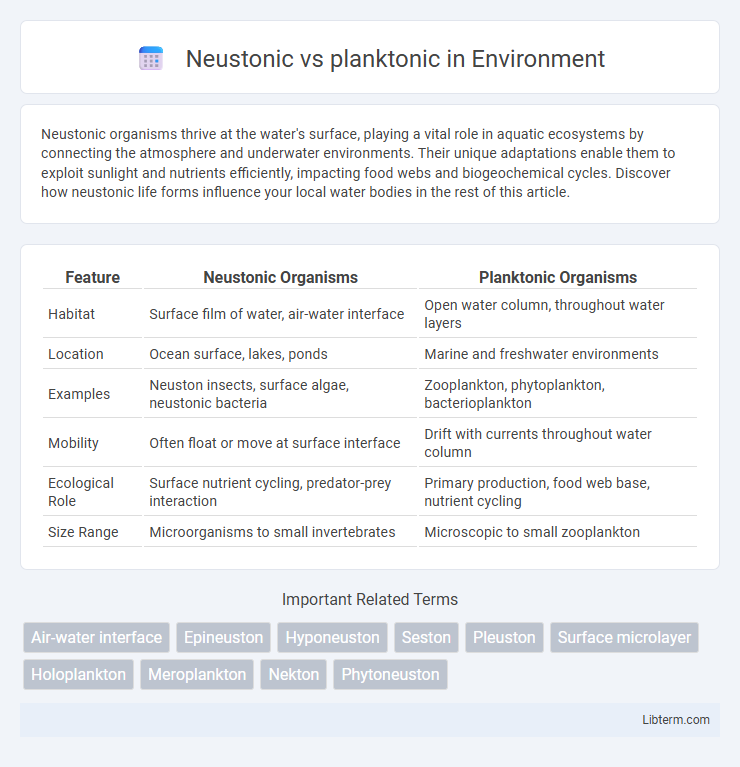Neustonic organisms thrive at the water's surface, playing a vital role in aquatic ecosystems by connecting the atmosphere and underwater environments. Their unique adaptations enable them to exploit sunlight and nutrients efficiently, impacting food webs and biogeochemical cycles. Discover how neustonic life forms influence your local water bodies in the rest of this article.
Table of Comparison
| Feature | Neustonic Organisms | Planktonic Organisms |
|---|---|---|
| Habitat | Surface film of water, air-water interface | Open water column, throughout water layers |
| Location | Ocean surface, lakes, ponds | Marine and freshwater environments |
| Examples | Neuston insects, surface algae, neustonic bacteria | Zooplankton, phytoplankton, bacterioplankton |
| Mobility | Often float or move at surface interface | Drift with currents throughout water column |
| Ecological Role | Surface nutrient cycling, predator-prey interaction | Primary production, food web base, nutrient cycling |
| Size Range | Microorganisms to small invertebrates | Microscopic to small zooplankton |
Introduction to Neustonic and Planktonic Organisms
Neustonic organisms inhabit the surface microlayer of aquatic environments, playing critical roles in nutrient cycling and energy transfer across marine and freshwater ecosystems. Planktonic organisms, including phytoplankton and zooplankton, drift within the water column, serving as fundamental components of aquatic food webs and primary producers. Understanding the distinct ecological niches and adaptations of neustonic versus planktonic organisms is essential for studying biodiversity and ecosystem dynamics in aquatic habitats.
Defining Neustonic: Life at the Water's Surface
Neustonic organisms inhabit the thin surface layer of aquatic environments, thriving at the interface between water and air where sunlight penetration and oxygen availability are optimal. These life forms, including certain insects, algae, and bacteria, are adapted to exploit the unique physical and chemical properties of the water surface, playing critical roles in nutrient cycling and energy transfer. In contrast, planktonic organisms drift within the water column, spanning various depths and often relying on buoyancy and water currents for mobility and dispersion.
Understanding Planktonic: Drifters in the Water Column
Planktonic organisms drift passively in the water column, relying on currents for movement, which distinguishes them from Neustonic organisms that live at the water surface. Their distribution is influenced by factors such as water temperature, salinity, and nutrient availability, playing a critical role in aquatic food webs. Planktonic species include phytoplankton and zooplankton, which contribute significantly to oxygen production and carbon cycling in marine ecosystems.
Key Differences Between Neustonic and Planktonic Communities
Neustonic communities inhabit the surface film of aquatic environments, specifically the air-water interface, while planktonic communities drift freely throughout the water column. Neustonic organisms have specialized adaptations for surface tension, such as hydrophobic body parts, enabling them to exploit this unique niche, whereas planktonic organisms rely on buoyancy and water currents for movement and distribution. The ecological roles also differ significantly, with neustonic species playing crucial roles in gas exchange and surface-mediated nutrient cycling, contrasting with planktonic communities that are integral to primary production and food web dynamics throughout various depths.
Ecological Roles of Neustonic Organisms
Neustonic organisms occupy the surface microlayer of aquatic environments, playing a critical role in nutrient cycling and energy transfer within marine and freshwater ecosystems. These surface dwellers act as a vital link between the atmosphere and the water column, influencing gas exchange, organic matter decomposition, and serving as a food source for higher trophic levels, unlike planktonic organisms that primarily inhabit the water column. Neustonic species contribute to the breakdown of pollutants and support biodiversity by providing habitat and feeding grounds for various microorganisms and small invertebrates.
Ecological Importance of Planktonic Species
Planktonic species play a crucial role in aquatic ecosystems by serving as the foundational base of the marine food web, supporting a wide range of organisms from small fish to large whales. Their photosynthetic activity contributes significantly to global oxygen production and carbon sequestration, impacting climate regulation. Unlike neustonic organisms that inhabit the water surface, planktonic species occupy various depths, enhancing nutrient cycling and energy flow throughout ocean layers.
Adaptations Unique to Neustonic Life
Neustonic organisms exhibit specialized adaptations such as hydrophobic body surfaces and flattened morphologies to maintain buoyancy at the water-air interface, enabling efficient exploitation of surface tension and light availability. Their sensory systems are often tuned to detect changes in surface conditions, granting them enhanced predator avoidance and prey detection in the neuston layer. These unique adaptations contrast with planktonic species, which are generally adapted for suspension feeding and vertical migration in the water column.
Adaptations Distinctive to Planktonic Life
Planktonic organisms exhibit specialized adaptations such as transparent bodies and streamlined shapes to reduce predation and enhance buoyancy in open water. They possess gelatinous or lipid-rich tissues that increase flotation, enabling them to remain suspended in the photic zone for optimal light exposure and feeding. Rapid reproduction and drifting capabilities allow planktonic species to exploit nutrient-rich currents efficiently, distinguishing their survival strategies from Neustonic organisms anchored to surface films.
Environmental Threats to Neustonic and Planktonic Populations
Neustonic populations, residing at the water-air interface, face significant threats from oil spills and surface pollutants that disrupt their delicate habitat, while planktonic populations are more vulnerable to changes in water temperature, acidification, and nutrient depletion caused by climate change. Microplastic contamination critically impacts both neustonic and planktonic organisms by causing ingestion and toxicity, leading to altered reproductive success and mortality rates. These environmental threats contribute to the destabilization of marine food webs and reduce biodiversity, jeopardizing the ecological functions performed by these populations.
Future Research Directions in Neustonic and Planktonic Studies
Future research in neustonic and planktonic studies aims to enhance understanding of species interactions and ecosystem dynamics within surface and water column habitats, with emphasis on molecular techniques and remote sensing technologies. Investigations into climate change impacts on neustonic and planktonic communities seek to reveal shifts in distribution and biodiversity, improving predictive models for marine spatial planning. Cross-disciplinary approaches integrating oceanography, genomics, and bioinformatics will drive innovations in monitoring and mitigating anthropogenic effects on these critical marine assemblages.
Neustonic Infographic

 libterm.com
libterm.com